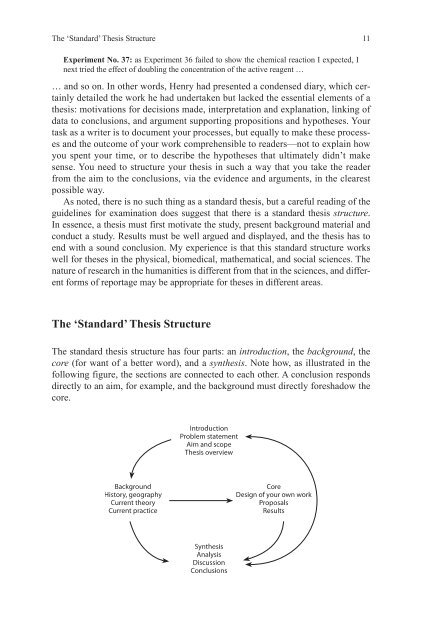How-to-Write-a-Better-Thesis
You also want an ePaper? Increase the reach of your titles
YUMPU automatically turns print PDFs into web optimized ePapers that Google loves.
The ‘Standard’ <strong>Thesis</strong> Structure <br />
11<br />
Experiment No. 37: as Experiment 36 failed <strong>to</strong> show the chemical reaction I expected, I<br />
next tried the effect of doubling the concentration of the active reagent …<br />
… and so on. In other words, Henry had presented a condensed diary, which certainly<br />
detailed the work he had undertaken but lacked the essential elements of a<br />
thesis: motivations for decisions made, interpretation and explanation, linking of<br />
data <strong>to</strong> conclusions, and argument supporting propositions and hypotheses. Your<br />
task as a writer is <strong>to</strong> document your processes, but equally <strong>to</strong> make these processes<br />
and the outcome of your work comprehensible <strong>to</strong> readers—not <strong>to</strong> explain how<br />
you spent your time, or <strong>to</strong> describe the hypotheses that ultimately didn’t make<br />
sense. You need <strong>to</strong> structure your thesis in such a way that you take the reader<br />
from the aim <strong>to</strong> the conclusions, via the evidence and arguments, in the clearest<br />
possible way.<br />
As noted, there is no such thing as a standard thesis, but a careful reading of the<br />
guidelines for examination does suggest that there is a standard thesis structure.<br />
In essence, a thesis must first motivate the study, present background material and<br />
conduct a study. Results must be well argued and displayed, and the thesis has <strong>to</strong><br />
end with a sound conclusion. My experience is that this standard structure works<br />
well for theses in the physical, biomedical, mathematical, and social sciences. The<br />
nature of research in the humanities is different from that in the sciences, and different<br />
forms of reportage may be appropriate for theses in different areas.<br />
The ‘Standard’ <strong>Thesis</strong> Structure<br />
The standard thesis structure has four parts: an introduction, the background, the<br />
core (for want of a better word), and a synthesis. Note how, as illustrated in the<br />
following figure, the sections are connected <strong>to</strong> each other. A conclusion responds<br />
directly <strong>to</strong> an aim, for example, and the background must directly foreshadow the<br />
core.














![[Lonely Planet] Sri Lanka](https://img.yumpu.com/59845622/1/169x260/lonely-planet-sri-lanka.jpg?quality=85)


